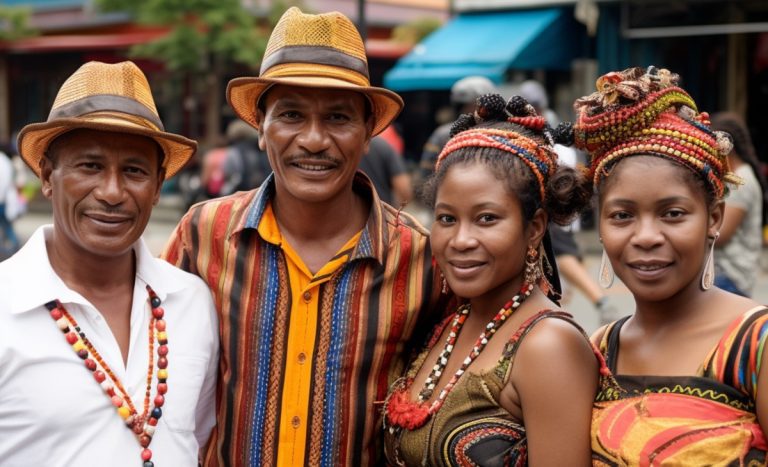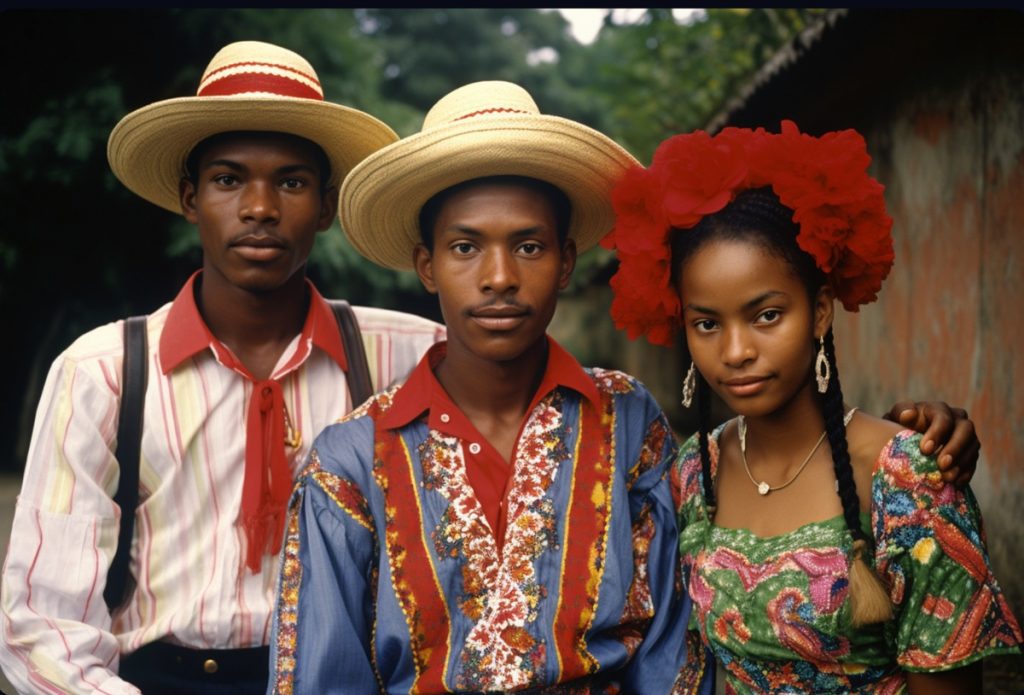During our travels through Ecuador, my wife and I were fortunate enough to explore not just the breathtaking mountains and the serene coastal areas but also to meet some incredibly vibrant communities, including the Afro-Ecuadorians. From the moment we arrived, we could feel the pulse of their culture, a mix of music, dance, and resilience that truly stood out.
For far too long, these communities have been overlooked and marginalized. We learned about their deep history and how their ancestors endured hardships during the Spanish conquest and slavery. Hearing some of these stories firsthand while chatting with locals gave us a sense of the long journey they’ve been on, and it made us appreciate their strength even more.
Nowadays, though, there’s a shift happening. Afro-Ecuadorians are finally receiving the recognition they deserve. Their cultural heritage, filled with vibrant music, flavorful cuisine, and intricate traditions, is gaining visibility both in Ecuador and worldwide. My wife and I were especially moved by the energy of their music—it’s impossible not to tap your feet when the rhythms fill the air.
In this post, we’ve gathered some of the history and traditions that Afro-Ecuadorians have worked so hard to preserve. It’s a story of perseverance, pride, and a rich culture that continues to thrive despite the challenges they’ve faced. We hope our experiences and the insights we gained help paint a picture of just how special this community is.
Afro-Ecuadorian’s History
When my wife and I delved into the history of Afro-Ecuadorians during our trip, we were struck by their incredible resilience and relentless fight for freedom. Learning about their past was eye-opening, especially when we discovered the many acts of rebellion and resistance they led during the era of slavery.
Some Afro-Ecuadorians escaped captivity and sought refuge along the coast, blending into free Black communities, while others in the Chota Valley took a more direct route—rising up against their owners between 1710 and 1820. What really stood out to us was how some even fought for their freedom through legal means, seeking justice in the colonial courts, a bold move for the time. It added another layer of complexity to their fight, showing how they used every available avenue to resist their oppression.
During Simon Bolivar’s campaign for South America’s independence, many Afro-Ecuadorians joined his army, driven by the hope that victory would bring them freedom. Yet, despite these sacrifices, it took almost half a century after Ecuador’s independence in 1809 for slavery to be officially abolished in 1854. Standing on the very land where these struggles unfolded made us reflect deeply on the harsh reality they faced—freedom came at a price, and unfortunately, it wasn’t compensated. The government didn’t offer reparations to the newly freed; instead, it compensated the former slave owners. This left many Afro-Ecuadorians with little choice but to continue working for those who once held them in bondage, creating a lingering sense of injustice that still echoes today.
As we spent time talking to locals, we heard firsthand accounts of the ongoing challenges Afro-Ecuadorians face in integrating into broader Ecuadorian society. Racism and prejudice are still very much alive, especially from white and mestizo Ecuadorians. Despite this, we were inspired by the unyielding spirit we saw. Afro-Ecuadorians continue to push through these barriers, striving for equal rights and recognition.
Their journey has been long and difficult, but their cultural contributions—whether it’s the infectious music, rich traditions, or vibrant spirit—are an essential part of what makes Ecuador so unique. My wife and I left with a deep respect for this community and their role in shaping the nation’s identity.
Afro-Ecuadorian Communities
During our trip, one of the highlights for my wife and me was visiting the Esmeraldas Province, a coastal region rich in Afro-Ecuadorian culture. As we arrived, we could immediately feel the pulse of life here—this place is known for its lively music and vibrant dances, especially the “Currulao,” which we were lucky enough to experience firsthand. Watching the locals move with such energy and rhythm was mesmerizing, and it gave us a glimpse into the deep cultural roots that define this community.
We also indulged in the local seafood, which was absolutely mouthwatering. The dishes, steeped in Afro-Ecuadorian traditions, reflected the blend of flavors that have been passed down through generations. Freshly caught fish, seasoned just right, and coconut-infused recipes brought out the true essence of coastal cuisine. Every bite was a reminder of how Afro-Ecuadorian culture has shaped not just the music and dance, but also the flavors of Ecuador’s northern coast.
Each region of the country where Afro-Ecuadorians live has its own unique touch, but the Esmeraldas Province truly stood out to us for its vibrant and welcoming atmosphere. It was an unforgettable experience, one that connected us deeply with the local way of life.
As my wife and I ventured deeper into Ecuador, we found that each region with an Afro-Ecuadorian presence brought its own unique flavor and history. One of the most fascinating areas we explored was the Valle del Chota in the Imbabura Province. This valley, surrounded by dramatic landscapes, is home to a thriving Afro-Ecuadorian community that proudly celebrates its heritage, particularly during the famous “San Juan” festival. The festival was unlike anything we had seen before, with vibrant music, energetic dance, and rituals that trace back generations. It was also a chance to see how much their agricultural roots, especially the cultivation of sugarcane, continue to be central to their way of life.
Our trip to Guayas Province took us to the bustling city of Guayaquil, where Afro-Ecuadorian influence is unmistakable. Music was everywhere—my wife and I couldn’t get enough of the local “Marimba” and “Caderona” styles that seemed to spill out from every street corner. These beats brought the city to life, giving us a sense of the cultural fusion happening there. And the food? Guayaquil’s Afro-Ecuadorian cuisine was a revelation. The dishes were so varied and full of flavor that we found ourselves trying something new at every meal, from rich stews to perfectly seasoned seafood that left us craving more.
We also discovered that smaller Afro-Ecuadorian communities dot the country, often hidden gems that offer a quieter but equally captivating glimpse into their culture. These lesser-known enclaves are perfect for anyone looking to go off the beaten path. My wife and I were met with warm hospitality everywhere we went, and each place had its own stories to tell, deepening our appreciation for the Afro-Ecuadorian contributions to Ecuador’s rich cultural tapestry.
Every stop was a reminder of how diverse and resilient these communities are, and how much their traditions have shaped the Ecuador we were fortunate enough to experience.
Afro-Ecuadorians in Esmeraldas
During our time in Esmeraldas, my wife and I couldn’t help but notice the stark contrasts between its cultural richness and the challenges the region has faced. We learned that because so many Afro-Ecuadorians call Esmeraldas home, the province has endured years of social, political, and economic neglect. It was eye-opening to hear how the government didn’t invest as much in basic things like education, public infrastructure, or business development. As we walked through some of the smaller towns, we could see signs of this neglect—schools that seemed underfunded and roads that needed care.
Despite these challenges, there was an undeniable sense of resilience in the people we met. And thankfully, change is starting to happen. We noticed that Esmeraldas is beginning to receive more attention, not only from the Ecuadorian government but also from tourists like us. The province is brimming with potential, and its stunning landscapes and vibrant Afro-Ecuadorian culture are drawing more visitors, bringing with them opportunities for growth.
One of the most memorable things we learned was how deeply Afro-Ecuadorians are connected to Ecuador’s national soccer team. Many of the team’s star players hail from Esmeraldas, and their success on the field is helping to bring more recognition and pride to the region. As we watched a local game one evening, surrounded by enthusiastic fans, it was easy to see how much these athletes mean to the community. It gave us hope that Esmeraldas’ time in the spotlight is just beginning, and that this region will continue to thrive and receive the appreciation it so richly deserves.
Afro-Ecuadorian’s Music
During our trip to Ecuador, my wife and I were blown away by how much Afro-Ecuadorians have shaped the country’s music scene. One of the most memorable moments for us was experiencing the lively sounds of the marimba, a style deeply rooted in Afro-Ecuadorian culture. The rhythmic beats and vibrant melodies filled the air wherever we went, especially in the coastal regions like Esmeraldas, where their musical influence is undeniable.
We quickly realized how central Afro-Ecuadorians and their ancestors have been in creating this captivating music. The marimba, with its upbeat tempo and intricate rhythms, seemed to tell the story of a people who have faced hardships but continue to celebrate life through song and dance. One evening, we stumbled upon a street performance, and it felt like the music had its own heartbeat—pulling us into its flow. Watching the performers play with such skill and passion, we could truly feel the depth of their cultural contributions.
For us, this music wasn’t just entertainment; it was a reminder of how Afro-Ecuadorians have left an indelible mark on the soul of Ecuador. Their garrulous style and marimba rhythms serve as a living tribute to their vibrant heritage, something we feel lucky to have experienced firsthand.
Plan perfect trip to Ecuador & Galapagos
I spent countless hours researching everything about traveling to Ecuador, and I created this blog for fellow travel enthusiasts who want the best, most reliable information. But if you want to save time, we’ve partnered with the top local agency to plan your dream trip.
While exploring the lively streets of Esmeraldas, my wife and I were introduced to something truly special: a unique twist on the traditional marimba genre called marimba salsa. This musical blend, which combines the rhythmic beats of the marimba with the energetic flair of salsa, immediately captivated us. It was like a bridge between the old and the new, honoring Afro-Ecuadorian traditions while embracing modern influences.
Hearing marimba salsera in its birthplace was an unforgettable experience. We watched as musicians seamlessly wove traditional marimba melodies into the upbeat tempo of salsa, creating a sound that felt fresh yet deeply rooted in history. For us, this fusion was more than just music—it was a powerful statement of cultural pride and resilience. Through these vibrant tunes, Afro-Ecuadorians are not only preserving their rich heritage but also asserting their place in Ecuador’s diverse cultural landscape.
Every note seemed to echo the spirit of celebration and survival, reminding us of the strength and creativity of the Afro-Ecuadorian community. Witnessing this cultural expression firsthand was one of the highlights of our trip, and it left us with a deep appreciation for the ways in which tradition and innovation can coexist in such a beautiful way.
Preservation Efforts for Afro-Ecuadorian Heritage
During our time in Ecuador, my wife and I were fortunate to witness how deeply committed the Afro-Ecuadorian community is to preserving its cultural heritage. It became clear to us that this preservation isn’t just about keeping traditions alive—it’s about passing them down from one generation to the next, ensuring that the heart and soul of their culture continues to thrive.
One evening, we had the chance to attend a community gathering where storytelling took center stage. Elders shared their wisdom through captivating stories, and we watched as younger members listened intently, absorbing the history, music, and rituals that have been passed down for centuries. It was a beautiful reminder of the power of oral tradition and how vital it is to the preservation of their heritage.
What really stood out to us was how Afro-Ecuadorians are also embracing modern technology to spread their culture even further. We came across several social media accounts where local artists and musicians were sharing their art with the world. It’s incredible to see how these digital platforms allow them to reach a global audience, showcasing their traditions, history, and talents to fellow Ecuadorians and people worldwide.
Tourism has also become an essential part of promoting Afro-Ecuadorian culture. We noticed that visitors, like ourselves, are drawn to the rich tapestry of their customs, supporting local artisans, musicians, and performers. By exploring these communities, we felt like we were contributing in a small way to the preservation of their culture, and it left us with a deep appreciation for the vibrant and resilient spirit of the Afro-Ecuadorian people.
Conclusion
As my wife and I traveled through Ecuador, we couldn’t help but admire the incredible journey of the Afro-Ecuadorian people. Their history is a testament to their tenacity and unwavering commitment to preserving their cultural heritage, despite centuries of adversity. Everywhere we went, we saw how their traditions continue to thrive, deeply embedded in Ecuador’s cultural fabric.
It’s heartening to see that as global awareness grows, Afro-Ecuadorians are finally receiving the recognition and appreciation they have long deserved. We could feel this shift in conversations with locals, as they proudly shared stories about their music, art, and history.
What struck us most was how boldly Afro-Ecuadorians have embraced their diverse cultural background. Rather than letting their past define them, they’ve taken immense pride in their roots, celebrating the rich fusion of African, indigenous, and Ecuadorian influences that shape their identity. Their enduring spirit and immense contributions to Ecuador’s cultural tapestry make it clear that Afro-Ecuadorians are an integral part of the nation’s identity, standing strong and vibrant in their place in Ecuador’s ever-evolving story.




